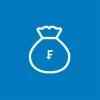My smartphone is an important companion for me. That’s why I personally think neobanks mixing up the financial space is a good thing. Now I can even manage my retirement savings on my phone. I’ve been saving for retirement with the pillar 3a for years now – both to provide for my future self, and to save a pretty penny on taxes.
I suppose at this point you’ll be asking which pillar 3a retirement app lets you save the most money for retirement. To answer that question, I conducted a simple experiment: I deposited money into six different app-based retirement saving services and sat back to see how the capital grew.
Naturally I only included services with which I could easily open an account. I only wanted to pay money into the pillar 3a, without opening any other accounts or using any other services. In the end I settled on digital retirement saving pioneer Viac, independent service providers Descartes, Finpension, Selma, and Sparbatze, and the frankly app from the Zürcher Kantonalbank.
On December 10, 2020, I used online banking to transfer identical amounts of 500 francs into each of the six retirement apps included in my experiment. The money was invested in the product recommended by the service provider for those looking for a large stock component (up to 97 percent, depending on the service provider). On December 20, 2021, I transferred a second batch of 500-franc deposits via online banking.
How did the different service providers compare? The table below shows how much money was in each account on January 4, 2022 – around one year after my first deposit.
| App |
Final savings |
Growth |
| Frankly (Zürcher Kantonalbank) |
1125 |
12.5% |
| Selma |
1122 |
12.2% |
| Viac |
1115 |
11.5% |
| Finpension |
1107 |
10.7% |
| Sparbatze |
1069 |
6.9% |
| Descartes |
1054 |
5.4% |
As you can see, there are a number of differences: I have nearly 7 percent more in my Frankly account than in my Descartes account.
It’s too bad that past returns do not provide a clear picture of what future developments will look like. Otherwise, it would be pretty obvious which app I would choose for future pillar 3a savings. But until I develop fortune-telling abilities, I prefer to pick my retirement app based on the lowest costs and fees.
I do find it interesting how the differences can be so big in this regard: The costs and fees of retirement apps are often less than half a percent. At established, conventional banks, they can be more than 1.5 percent. But I’m used to these kind of big price differences from the telecom space.
Of course, my experiment last year is not a scientific comparison. For example, just the fact that not all service providers invest the money I deposit at the same time could have had an impact on the outcomes. On top of that, the time frame was relatively short for the kind of investment products used. But my little experiment does at least show that it makes a difference which retirement app you choose. Naturally, I plan to continue paying into retirement apps as part of my ongoing experiment, and give you occasional updates on how things progress.
Finally, I’d like to make a note about Sparbatze: I received an email a few days ago informing me that its operator is shutting down. So due to those circumstances, that app likely will not be included in my next pillar 3a experiment update. I am excited to see whether new retirement apps will appear in the future. In every case, any new service provider will have to conjure up a pretty good plan for acquiring enough customers.
What is your experience with retirement apps? Or do you stick to conventional solutions? Share your experiences in the forum.
More on this topic:
A guide to Swiss digital retirement asset management services
Swiss retirement fund comparison

 Deal of the Day
Deal of the Day 







